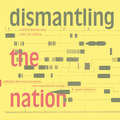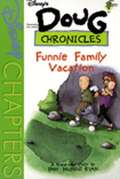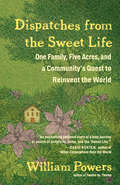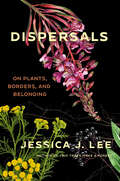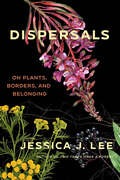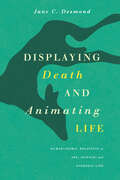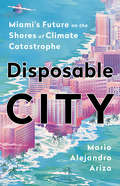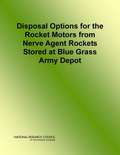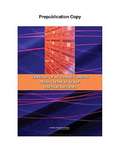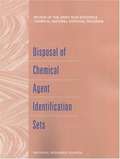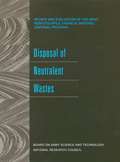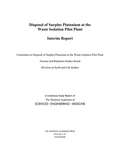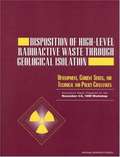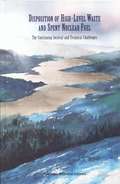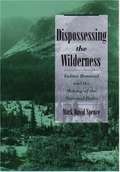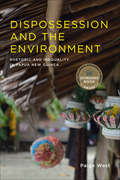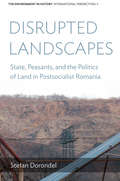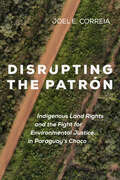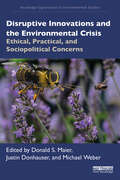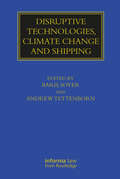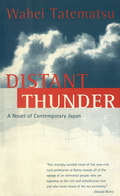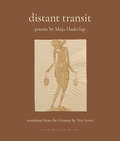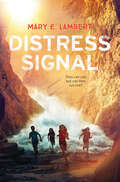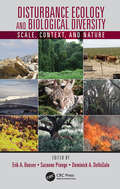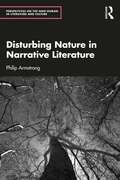- Table View
- List View
Dismantling the Nation: Contemporary Art in Chile
by Florencia San MartínThe first volume to theorize and historicize contemporary artistic practices from Chile in the English language, Dismantling the Nation begins from a position of radical criticism against the nation-state of Chile and its capitalist, heteronormative, and extractivist rule. At a truly pivotal moment in the country’s history, when it is redefining what it wants to be, the works here propose a way of forging a feminist and decolonial future for Chile. The authors attend to practices from distinct locations in Chile, reconceptualizing geographical borders from a transnational and transdisciplinary perspective while engaging with ecocriticism and Indigenous epistemologies. This is an essential volume for anyone looking to understand the current social, political, and artistic movements in Chile.
Disney's Doug Chronicles: The Funnie Family Vacation - Book #10
by Pam Muñoz RyanDoug is sure his summer is completely doomed when he has to go on a week-long camping trip with his entire family. To top it all off, he has to miss Beebe's annual swim party.
Dispatches from the Sweet Life: One Family, Five Acres, and a Community's Quest to Reinvent the World
by William PowersMany fantasize about dramatically changing their lives — living in accordance with their ideals rather than the exigencies of job, bills, and possessions. William Powers actually does it. In his book Twelve by Twelve, Powers lived in an off-grid tiny house in rural North Carolina. In New Slow City, he and his wife, Melissa, inhabited a Manhattan micro-apartment in search of slow in the fastest city in the world. Here, the couple, with baby in tow, search for balance, community, and happiness in a small town in Bolivia. They build an adobe house, plant a prolific orchard and organic garden, and weave their life into a community of permaculturists, bio-builders, artists, and creative businesspeople. Can this Transition Town succeed in the face of encroaching North American capitalism, and can Powers and the other settlers find the balance they’re seeking? Dispatches from the Sweet Life is compelling, sobering, thought-provoking, and, no matter the outcome, inspiring.
Dispersals: On Plants, Borders, and Belonging
by Jessica J. LeeINSTANT TORONTO STAR BESTSELLERThe prize-winning and bestselling author of Two Trees Make a Forest turns to the lives of plants entangled in our human world to explore belonging, displacement, identity, and the truths of our shared futureA seed slips beyond a garden wall. A tree is planted on a precarious border. A shrub is stolen from its culture and its land. What happens when these plants leave their original homes and put down roots elsewhere?The themes in these fourteen essays become invigorating and intimate in Lee&’s hands, centering on the lives of plants like seaweed, tangelos, and soy, and their entanglement with our human worlds. Lee explores the rich backstory of cherry trees in Berlin; a tea plant that grows in the Himalayan foothills just southwest of China; the world of algae and wakame, and the journeys they&’ve made to reach us.Each of the plants considered in this collection are somehow perceived as being &“out of place&”—weeds, samples collected through imperial science, crops introduced and transformed by our hand. Lee looks at these plant species in their own context, even when we find them outside of it.Dispersals draws a gorgeous, sprawling map of the diaspora of flora. Combining memoir, history, and scientific research in poetic prose, Jessica J. Lee meditates on the question of how both plants and people come to belong, why both cross borders, and how our futures are more entwined than we might imagine.
Dispersals: On Plants, Borders, and Belonging
by Jessica J. LeeA prize-winning memoirist and nature writer turns to the lives of plants entangled in our human world to explore belonging, displacement, identity, and the truths of our shared futureA seed slips beyond a garden wall. A tree is planted on a precarious border. A shrub is stolen from its culture and its land. What happens when these plants leave their original homes and put down roots elsewhere?In fourteen essays, Dispersals explores the entanglements of the plant and human worlds: from species considered invasive, like giant hogweed; to those vilified but intimate, like soy; and those like kelp, on which our futures depend. Each of the plants considered in this collection are somehow perceived as being &‘out of place&’—weeds, samples collected through imperial science, crops introduced and transformed by our hand. Combining memoir, history, and scientific research in poetic prose, Jessica J. Lee meditates on the question of how both plants and people come to belong, why both cross borders, and how our futures are more entwined than we might imagine.
Displaying Death and Animating Life: Human-Animal Relations in Art, Science, and Everyday Life (Animal Lives Ser.)
by Jane C. DesmondThe number of ways in which humans interact with animals is almost incalculable. From beloved household pets to the steak on our dinner tables, the fur in our closets to the Babar books on our shelves, taxidermy exhibits to local zoos, humans have complex, deep, and dependent relationships with the animals in our ecosystems. In Displaying Death and Animating Life, Jane C. Desmond puts those human-animal relationships under a multidisciplinary lens, focusing on the less obvious, and revealing the individualities and subjectivities of the real animals in our everyday lives. Desmond, a pioneer in the field of animal studies, builds the book on a number of case studies. She conducts research on-site at major museums, taxidermy conventions, pet cemeteries, and even at a professional conference for writers of obituaries. She goes behind the scenes at zoos, wildlife clinics, and meetings of pet cemetery professionals. We journey with her as she meets Kanzi, the bonobo artist, and a host of other animal-artists--all of whom are preparing their artwork for auction. Throughout, Desmond moves from a consideration of the visual display of unindividuated animals, to mourning for known animals, and finally to the marketing of artwork by individual animals. The first book in the new Animal Lives series, Displaying Death and Animating Life is a landmark study, bridging disciplines and reaching across divisions from the humanities and social sciences to chart new territories of investigation.
Disposable City: Miami's Future on the Shores of Climate Catastrophe
by Mario Alejandro ArizaA deeply-reported personal investigation by a Miami journalist into the present and future effects of climate change in the Magic City-a watery harbinger for coastal cities worldwide.Miami, Florida, is likely to be entirely underwater by the end of this century. Residents are already starting to see the effects of sea level rise today. From sunny day flooding caused by higher tides to a sewer system on the brink of total collapse, the city undeniably lives in a climate changed world. In Disposable City, Miami resident Mario Alejandro Ariza shows us not only what climate change looks like on the ground today, but also what Miami will look like 100 years from now, and how that future has been shaped by the city's racist past and present. As politicians continue to kick the can down the road and Miami becomes increasingly unlivable, real estate vultures and wealthy residents will be able to get out or move to higher ground, but the most vulnerable communities, disproportionately composed of people of color, will face flood damage, rising housing costs, dangerously higher temperatures, and stronger hurricanes that they can't afford to escape. Miami may be on the front lines of climate change, but the battle it's fighting today is coming for the rest of the U.S.--and the rest of the world--far sooner than we could have imagined even a decade ago. Disposable City is a thoughtful portrait of both a vibrant city with a unique culture and the social, economic, and psychic costs of climate change that call us to act before it's too late.
Disposal Options for the Rocket Motors From Nerve Agent Rockets Stored at Blue Grass Army Depot
by National Research Council Board on Army Science and Technology Division on Engineering and Physical Sciences Committee on Disposal Options for the Rocket Motors of Nerve Agent Rockets at Blue Grass Army DepotThe Blue Grass Chemical Agent-Destruction Pilot Plant (BGCAPP) is under construction near Richmond, Kentucky, two dispose of one of the two remaining stockpiles of chemical munitions in the United States. The stockpile that BGCAPP will dispose of is stored at the Blue Grass Army Depot (BGAD). BGCAPP is a tenant activity on BGAD. The stockpile stored at BGAD consists of mustard agent loaded in projectiles, and the nerve agents GB and VX loaded into projectiles and M55 rockets. BGCAPP will process the rockets by cutting them, still in their shipping and firing tube (SFT), between the warhead and motor sections of the rocket. The warhead will be processed through BGCAPP. The separated rocket motors that have been monitored for chemical agent and cleared for transportation outside of BGCAPP, the subject of this report, will be disposed of outside of BGCAPP. Any motors found to be contaminated with chemical agent will be processed through BGCAPP and are not addressed in this report. Disposal Options for the Rocket Motors From Nerve Agent Rockets Stored at Blue Grass Army Depot addresses safety in handling the separated rocket motors with special attention to the electrical ignition system, the need for adequate storage space for the motors in order to maintain the planned disposal rate at BGCAPP, thermal and chemical disposal technologies, and on-site and off-site disposal options. On-site is defined as disposal on BGAD, and off-site is defined as disposal by a commercial or government facility outside of BGAD.
Disposal of Activated Carbon from Chemical Agent Disposal Facilities
by National Research Council of the National AcademiesFor the last two decades, the United States has been destroying its entire stockpile of chemical agents. At the facilities where these agents are being destroyed, effluent gas streams pass through large activated carbon filters before venting to ensure that any residual trace vapors of chemical agents and other pollutants do not escape into the atmosphere in exceedance of regulatory limits. All the carbon will have to be disposed of for final closure of these facilities to take place. In March 2008, the Chemical Materials Agency asked the National Research Council to study, evaluate, and recommend the best methods for proper and safe disposal of the used carbon from the operational disposal facilities. This volume examines various approaches to handling carbon waste streams from the four operating chemical agent disposal facilities. The approaches that will be used at each facility will ultimately be chosen bearing in mind local regulatory practices, facility design and operations, and the characteristics of agent inventories, along with other factors such as public involvement regarding facility operations.
Disposal of Chemical Agent Identification Sets: Review of the Army Non-Stockpile Chemical Material Disposal Program
by National Research CouncilThe National Academies Press (NAP)--publisher for the National Academies--publishes more than 200 books a year offering the most authoritative views, definitive information, and groundbreaking recommendations on a wide range of topics in science, engineering, and health. Our books are unique in that they are authored by the nation's leading experts in every scientific field.
Disposal of Neutralent Wastes
by National Research Council Technology Board on Army ScienceInformation on the Disposal of Neutralent Wastes
Disposal of Surplus Plutonium at the Waste Isolation Pilot Plant: Interim Report
by Engineering Medicine National Academies of SciencesDisposal of Surplus Plutonium at the Waste Isolation Pilot Plant: Interim Report evaluates the general viability of the U.S. Department of Energy’s National Nuclear Security Administration’s (DOE-NNSA’s) conceptual plans for disposing of 34 metric tons (MT) of surplus plutonium in the Waste Isolation Pilot Plant (WIPP), a deep geologic repository near Carlsbad, New Mexico. This report evaluates DOE-NNSA’s plans to ship, receive, and emplace surplus plutonium in WIPP and its understanding of the impacts of these plans on WIPP and WIPP-bound waste streams. This report, the first of two to be issued during this study, provides a preliminary assessment of the general viability of DOE-NNSA’s conceptual plans, focusing on some of the barriers to their implementation.
Disposition of High-Level Radioactive Waste through Geological Isolation: Development, Current Status, and Technical and Policy Challenges
by Steering CommitteeThe National Academies Press (NAP)--publisher for the National Academies--publishes more than 200 books a year offering the most authoritative views, definitive information, and groundbreaking recommendations on a wide range of topics in science, engineering, and health. Our books are unique in that they are authored by the nation's leading experts in every scientific field.
Disposition of High-level Waste and Spent Nuclear Fuel: The Continuing Societal and Technical Challenges
by National Research CouncilFocused attention by world leaders is needed to address the substantial challenges posed by disposal of spent nuclear fuel from reactors and high-level radioactive waste from processing such fuel. The biggest challenges in achieving safe and secure storage and permanent waste disposal are societal, although technical challenges remain. Disposition of radioactive wastes in a deep geological repository is a sound approach as long as it progresses through a stepwise decision-making process that takes advantage of technical advances, public participation, and international cooperation. Written for concerned citizens as well as policymakers, this book was sponsored by the U.S. Department of Energy, U.S. Nuclear Regulatory Commission, and waste management organizations in eight other countries.
Dispossessing the Wilderness: Indian Removal and the Making of the National Parks
by Mark David SpenceNational parks like Yellowstone, Yosemite, and Glacier preserve some of this country's most cherished wilderness landscapes. While visions of pristine, uninhabited nature led to the creation of these parks, they also inspired policies of Indian removal. By contrasting the native histories of these places with the links between Indian policy developments and preservationist efforts, this work examines the complex origins of the national parks and the troubling consequences of the American wilderness ideal. The first study to place national park history within the context of the early reservation era, it details the ways that national parks developed into one of the most important arenas of contention between native peoples and non-Indians in the twentieth century.
Dispossession and the Environment: Rhetoric and Inequality in Papua New Guinea (Leonard Hastings Schoff Lectures)
by Paige WestWhen journalists, developers, surf tourists, and conservation NGOs cast Papua New Guineans as living in a prior nature and prior culture, they devalue their knowledge and practice, facilitating their dispossession. Paige West's searing study reveals how a range of actors produce and reinforce inequalities in today's globalized world. She shows how racist rhetorics of representation underlie all uneven patterns of development and seeks a more robust understanding of the ideological work that capital requires for constant regeneration.
Disrupted Landscapes: State, Peasants and the Politics of Land in Postsocialist Romania
by Stefan DorondelThe fall of the Soviet Union was a transformative event for the national political economies of Eastern Europe, leading not only to new regimes of ownership and development but to dramatic changes in the natural world itself. This painstakingly researched volume focuses on the emblematic case of postsocialist Romania, in which the transition from collectivization to privatization profoundly reshaped the nation's forests, farmlands, and rivers. From bureaucrats abetting illegal deforestation to peasants opposing government agricultural policies, it reveals the social and political mechanisms by which neoliberalism was introduced into the Romanian landscape.
Disrupting the Patrón: Indigenous Land Rights and the Fight for Environmental Justice in Paraguay's Chaco
by Joel E. CorreiaA free ebook version of this title is available through Luminos, University of California Press’s Open Access publishing program. Visit www.luminosoa.org to learn more. In Paraguay’s Chaco region, cattle ranching drives some of the world’s fastest deforestation and most extreme inequality in land tenure, with grave impacts on Indigenous well‑being. Disrupting the Patrón traces Enxet and Sanapaná struggles to reclaim their ancestral lands from the cattle ranches where they labored as peons—a decades-long resistance that led to the Inter‑American Court of Human Rights and back to the frontlines of Paraguay’s ranching frontier. The Indigenous communities at the heart of this story employ a dialectics of disruption by working with and against the law to unsettle enduring racial geographies and rebuild territorial relations, albeit with uncertain outcomes. Joel E. Correia shows that Enxet and Sanapaná peoples enact environmental justice otherwise: moving beyond juridical solutions to harm by maintaining collective lifeways and resistance amid radical social-ecological change. Correia’s ethnography advances debates about environmental racism, ethics of engaged research, and Indigenous resurgence on Latin America’s settler frontiers.
Disruptive Innovations and the Environmental Crisis: Ethical, Practical, and Sociopolitical Concerns (Routledge Explorations in Environmental Studies)
by Michael Weber Donald S. Maier Justin DonhauserThis book probes the ethical, practical, and sociopolitical implications of leveraging innovative and disruptive means to address the world’s various environmental crises.Packed with keen observations and analyses, the volume brings together research from seasoned scholars and rising stars to cast important new light on urgent issues engendered by humankind’s disruption of environments, such as climate change and biodiversity loss. It tackles the question of exactly what has been disrupted in the world—environmentally, economically, socially, and politically. It also examines an assortment of innovative interventions that aim to address disruptions and explores the question of what further disruptions may lurk behind assorted innovative interventions intended to address already existing disruptions. Chapters wrestle with the social, ethical, and ecological implications of disruptions, both pre-existing and those brought about by interventions, connected with deploying artificial gene drives, substituting robotic pollinators for living ones, synthesizing organisms to replace ones lost, installing economic regimes that work well for both citizens and the environment, making science subservient to non-scientific commitments, involving citizens in environmentally consequential decisions, choosing scientific and technological projects that most promise immediate practical payoff, and ensuring that respect for human rights is part and parcel of any technology-infused project. These discussions draw on a rich mix of science, philosophy of science, political theory, economics, sociology, network theory, ethics, and theories of justice and human rights.This book will be of great interest to students and scholars of environmental science, environmental decision-making, ecology, climate change, environmental philosophy, and the philosophy of science.
Disruptive Technologies, Climate Change and Shipping (Maritime and Transport Law Library)
by Simon Baughen Andrew Tettenborn Bariş SoyerThis book analyses the impact of two vital and contemporary developments on shipping law and practice: disruptive technologies and climate change. It considers the impact of these new technologies, honing in on likely emerging issues and unresolved questions, especially about existing and potential private law liabilities and concentrates, from the point of view of English, EU and international law, on the legal implications of climate change and associated environmental risks in the shipping sector. Written by a contributor team drawn from the most experienced and knowledgeable academics and practitioners in shipping law, this treatment of these growing areas of practice will be of great use to lawyers and administrators across the world.
Distant Thunder
by Wahei TatematsuWinner of the Noma Prize for New WritersSet in rural Japan at the height of the bubble economy, Distant Thunder tells of a farming village gradually effaced by urbanization, corruption, and greed. After Matsuzo Wada has sold off the family's lands and left his wife for another woman, his son Mitsuo is determined to support himself and his mother in the traditional manner, farming. All that remains of his ancestors' lands is a hothouse, in which he grows tomatoes to sell to the housewives from the nearby apartment complex, built on a former rice field. When his childhood friend, Koji, becomes entangled in an adulterous love affair which ultimately destroys him and those around him, Mitsuo begins to see how the town's hedonistic excesses are laying to waste not only the landscape, but also the communal and familial bonds and the values that once sustained them all.Translated from the Japanese by Lawrence J. Howell and Hikaru Morimoto.
Distant Transit: Poems
by Maja HaderlapFrom a groundbreaking Slovenian-Austrian poet comes an evocative, captivating collection on searching for home in a landscape burdened with violent history.At its core, Distant Transit is an ode to survival, building a monument to traditions and lives lost. Infused with movement, Maja Haderlap&’s Distant Transit traverses Slovenia&’s scenic landscape and violent history, searching for a sense of place within its ever-shifting boundaries. Avoiding traditional forms and pronounced rhythms, Haderlap unleashes a flow of evocative, captivating passages whose power lies in their associative richness and precision of expression, vividly conjuring Slovenia&’s natural world––its rolling meadows, snow-capped alps, and sparkling Adriatic coast. Belonging to the Slovene ethnic minority and its inherited, transgenerational trauma, Haderlap explores the burden of history and the prolonged aftershock of conflict––warm, lavish pastoral passages conceal dark memories, and musings on the way language can create and dissolve borders reveal a deep longing for a sense of home.
Distress Signal
by Mary E. LambertIn this edge-of-your-seat survival story, four classmates are stranded in a desert wilderness after a flash flood separates them from the rest of their grade. Can they make it to safety?Lavender's class is on a field trip in the desert of Chiricahua National Monument, hiking down a ravine, when a flash flood strikes!As the water hurtles down the ravine, everyone sprints for safety. Lavender runs in the opposite direction as the rest of her class and scrambles up a tree while the torrential river rages by.When the waters finally recede, Lavender finds herself stranded in the brutal heat of the desert with only her ex-best friend Marisol, mean-girl Rachelle, and a boy named John. They are shaken, disoriented, and have just one pack of supplies and the most basic wilderness knowledge. Can they find their way back to safety? They will have to learn to work together in spite of their differences -- if they want to survive.
Disturbance Ecology and Biological Diversity: Context, Nature, and Scale
by Erik A. Beever Inger Suzanne Prange Dominick A. DellaSalaThis book presents cascading effects of ecological disturbances on a multitude of ecosystem components. It includes agricultural development, large infrequent disturbances, forest harvesting, non-native grazing in deserts, ground transportation, powerline corridors, fires, urban ecology, disturbance in aquatic ecosystems, land-use dynamics on diversity, habitat fragmentation, sedimentation of wetlands, and contemporary climate change. The book facilitates users in understanding why disturbances are occurring while recommending mitigation and remediation strategies.
Disturbing Nature in Narrative Literature (Perspectives on the Non-Human in Literature and Culture)
by Philip ArmstrongDisturbing Nature in Narrative Literature identifies and analyses encounters with unexpected, disconcerting, and unsettling aspects of the natural world, as these have been represented across a wide range of literary texts. It includes in‑depth discussion of both familiar and less familiar works from the British, American, and European literary traditions, and from the Classical period to today. The motifs discussed include earthquakes, forests, storms, animals, and oceanic depth, and the writers include Virgil, Ovid, Dante, Shakespeare, Aphra Behn, Voltaire, Heinrich von Kleist, Herman Melville, H.G. Wells, J.R.R. Tolkien, Gabriel García Márquez, José Saramago, Margaret Atwood, and Annie Proulx. Rich in both close textual analysis and contextual discussion, Disturbing Nature in Narrative Literature offers a vivid introduction to several topical approaches to literary‑critical analysis, including ecocriticism, new materialism, affect theory, and human‑animal studies, thereby demonstrating how literature shapes and is shaped by our response to the pressing questions of our time.
